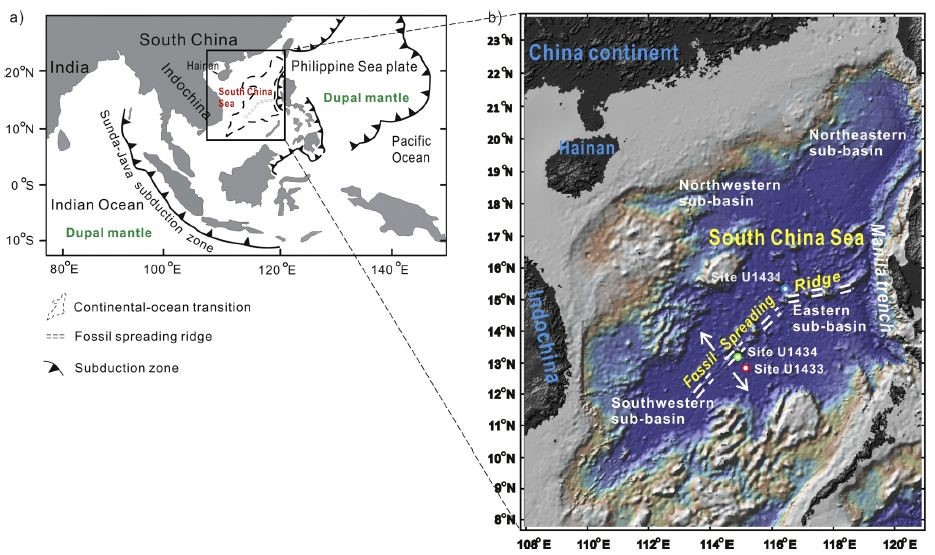The South China Sea was formed by rifting of the southeast Euro-Asia continent, and is one of the largest continental marginal basins in the western Pacific. It is located at the junction of the Euro-Asia continent, the Indian Ocean and the western Pacific Ocean (Figure 1), and this made the cause of opening of the South China Sea controversial. Based on that, it remains debated by geologists about the mantle type of the South China Sea, which means it is Pacific-type or Indian-type. The geochemical nature of sub-ridge mantle and opening dynamics of the South China Sea are faithfully and most likely recorded in extensional basin (basalts). However, due to that the South China Sea has been covered by sediments of more than one thousand meters thick, the seafloor basalt samples formed by seafloor spreading had not been obtained before. For the first time, the International Ocean Discovery Program (IODP) Expedition 349 that the researcher Guo-Liang Zhang joined has recovered seafloor basalts formed by ridge spreading in the Southwest sub-basin in 2014.

Fig. 1. Geologic setting of the South China Sea and sampling. (a) Tectonic setting of the western Pacific basins; (b) Map of the South China Sea and IODP Sites U1431, U1433 and U1434.
The team of Guo-Liang Zhang have leaded this study, and they have analyzed major and trace elements and Sr–Nd–Pb–Hf isotopes of the basalt samples in two sub-basins. They discovered distinctly difference of mantle soruce in the Southwest sub-basin and the East sub-basin. The Southwest sub-basin consists of enriched (E)-MORB type basalts, and the East sub-basin consists of both normal (N)-MORB-type and E-MORB-type basalts based on trace element compositions.The basalts of the two sub-basins are Indian-type (termed as Dupal anomaly based on geochemical study) MORBs based on Sr–Nd–Pb–Hf isotope compositions, and the Southwest sub-basin basalts show isotopic compositions distinctly different from the East sub-basin, suggesting a sub-basin scale mantle compositional heterogeneity and different histories of mantle compositional evolution.
In order to investigate the genesis of the Indian-type mantle in the South China Sea and the cause of different mantle compositional evolution between both sub-basins, the team of Guo-Liang Zhang have modeled the influence of the Hainan mantle plume and lower continental crust.The results indicate that a significant amount (up to 40%) of Hainan plume material is required by the isotopic geochemistry in the East sub-basin, which reflect the mixing relationship between Hainan plume component and the Pacific-type depleted mantle, and the compositional nature (e.g. low 206Pb/204Pb) of the Southwest sub-basin basalts can be explained by the recycling of lower continental crust during the opening of the South China Sea. Both Hainan plume and lower continental crust have the characteristics of Dupal anomaly, and this is right the reason of existing Indian-type mantle in the South China Sea. In terms of this, they propose a model of initiated spreading of the South China Sea: the Hainan plume might have promoted the opening of the South China Sea, during which the Hainan plume contributed enriched component to the sub-ridge mantle and caused thermal erosion and return of lower continental crust to the convective mantle.
This study reports geochemical nature of extensional oceanic crust in the International Ocean Discovery Program (IODP) Expedition 349, and shows that the South China Sea has characteristics of Indian-type mantle source and the two sub-basins in east and west show apparently different mantle source nature. It also proposes that the Hainan plume might have promoted the opening of the South China Sea, during which the Hainan plume contributed enriched component to the sub-ridge mantle and caused thermal erosion and return of lower continental crust to the convective mantle.
Author: Prof. Guoliang Zhang zhangguoliang@qdio.ac.cn
|
|

Address: 7 Nanhai Road, Qingdao, Shandong 266071, China
Tel: 86-532-82898902 Fax: 86-532-82898612 E-mail: iocas@qdio.ac.cn


